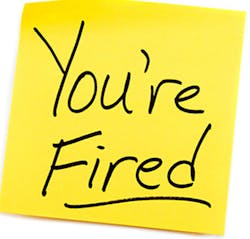Anyone who’s been a manager in this business for very long has likely had to fire an employee. Firing someone is never pleasant, so why do it?
The usual reasons range from poor attitude to poor competence. The person just isn’t working out. Maybe the employee is more of a detriment to your business than an asset to it.
But it doesn’t have to be a dire situation for termination to make sense. Maybe an employee just isn’t showing the drive to grow in the job, and you want someone who does. So we go through the pain of firing an employee who doesn’t measure up, and we find months later that we’re better off.
Suppose you inquire about Joe some months after letting him go. He’s working for a shop with a different vibe from yours and by all reports is very happy there. That’s a positive affirmation that your decision was best for all concerned.
But what if you fired Joe for coming to work drunk one time too many? You find out a year later he’s on his third job since you fired him, and he’s not long for that place either. That’s negative affirmation, but it does show that your decision was best for your company and for your employees whose personal safety depended on Joe.
Firing bad employees is an issue we can handle, but what many electrical firms don’t handle well is firing bad customers.
The circumstances will be different, but some similarities exist. Consider incompetence. The customer always sends you CAD drawings that are not on grid. You must pay one of your employees to redo the entire drawing. The customer asserts that his drawings are fine and refuses to pay for this. It doesn’t matter that using them as is would greatly add to the electrical design work.
Or maybe the customer is one of those who can never decide on a job specification no matter how far along the project is. Then, you’re supposed to eat the cost of the changes.
Consider the drinking example. That’s really a safety problem. What if your customer has a lax attitude toward safety? If you arrive on site and see the customer’s own employees are operating machinery without wearing eye protection, you should have concerns about sending your people in there.
But suppose your people hang locks and tags on breakers and the customer’s operator cuts a lock and removes a tag from a breaker. What is the response from that person’s supervisor? Is the customer deeply apologetic for this OSHA violation? Does the plant manager personally contact you about this? Did the customer take action to prevent another instance, such as disciplining the employee with unpaid time off work or outright termination?
If the customer doesn’t take safety seriously, this is a strong reason to terminate that customer. An ideal customer observes the work your people are doing and brings questions or comments to your onsite foreman or to the project manager.
This kind of feedback, via these channels, is valuable. But the customer should not abuse the situation by hovering over your employees or bothering them about how they do their work. The customer is not a supervisor on your payroll, and your employees do not report to your customer unless that is the specific arrangement made for a particular job.
Customers who assume that authority are overstepping their bounds. Termination would be appropriate if the behavior persists.
Of course, there are some exceptions to this line of thinking. Safety violations, for example, are well within a customer’s authority to act upon. If one of your employees is walking around with his safety glasses off, make sure to thank the customer’s employee who told your employee to put them on.
Then there’s the customer who wants a special (unearned) discount, demands free things throughout the project, and is continually late paying invoices. How much does all that discounting cost you when a customer is late paying an invoice and you’ve had to borrow to make up the difference? This customer may simply not be worth keeping on as an account. A customer who steals from you by dint of paying invoices late is probably cheating you in other ways, too.
Another class of customer to terminate is the one who exhibits the same kind of behavior that is nearly an automatic ticket for employee dismissal. That behavior is badmouthing your company.
A typical way this happens is the plant engineer or some other contact receives criticism during a staff meeting, and tries to deflect blame by badmouthing your company. This means the decision makers are being negatively influenced about your reputation. They may talk with decision makers at other companies, and suddenly your work dries up.
If you merely catch a rumor, take the customer to lunch and discuss what you can do better and what’s at the root of what you’re hearing. Ask the customer what he likes about your company, say something positive about his company and him personally, and end the conversation on that note.
If you can verify that the customer is still badmouthing your company, stop working for that company. Let a competitor get the reputation damage, instead.
Don’t be afraid to fire a bad customer. Before you act, verify the relevant facts. See if you can work something out. If you do fire the customer, take care not to burn bridges. Don’t make accusations. You can help everyone save face by simply saying your company is going in a different direction and regretfully, you will have to end the relationship.
It may help to provide the customer with contact information for a couple of other companies that are qualified to take your place. If you need to terminate a customer relationship, make an extreme effort not to leave them hanging by quitting in the middle of a project. That can severely damage your reputation. The obvious exception is if the issue is if the job puts the safety of your employees in jeopardy.





